Children, if allowed, express their unique energy pattern completely raw, pure, and uninhibited and a homeopathic physician may get overwhelmed observing the entire pattern unfolding in front of him. Though it is important for a homeopath to be vigilant, sensitive, observant and skillful to capture the raw energy pattern of a child that unfolds itself in his consulting room, it is vitally important for a homeopath to provide a pregnant space to each of his cases (including children) that can help their patient to outpour their sub conscious and beyond with spontaneity.
And this pregnant space is what Dinesh names Passive phase of case witnessing. I call this space to be pregnant, because it has so much to offer! For the patient, allowing this space causes smooth, spontaneous, uninhibited outpouring of his inner self; and for a homeopath, this space initiates clarity and enables a homeopath to know:
-
What stage of the case he is in,
-
How much journey is still left to reach the vital core of his patient,
-
How to travel that journey,
-
How much more time it may take to get there (vital core)
-
What types of defenses patient is throwing
-
How tointelligently tackle the defenses thrown
The importance of passive case witnessing is it allows and offers a free space to the patient where they can find a connection with their deeper self, to come up with those PQRS which we can otherwise miss if we start intervening initially with our pre-formed question list to make a reportorial-totality.
Allowing the pregnant space (the Passive phase of case witnessing) in the initial stage of cases means allowing a smooth journey when a homeopath intervenes actively, (what Dinesh calls Active and Active-Active phases of case witnessing) to follow the unique energy pattern of the case.
I would like to share a case from my clinic of a three and a half year old girl child. Here, allowing this Passive space helped me to get all her peculiar expressions through her gestures and her drawings – all her PQRS expressions. Then I actively intervened to understand her deeper core and prescribe her an appropriate simillimum.
Each child has their own peculiar way of expressing their energy pattern, and the children are so closely in touch with their sub conscious self (*1); some expresses their selves through their fears, some through their dreams, some through their use of drawings, and so on and so forth. This particular child came raw in expressing her energy pattern when I allowed her to stay in her space and she opened up through her drawings.
This is how the case unfolds:
(NOTE: The case has been edited for brevity. 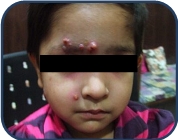
A three and a half year old baby B.P. saw me on 25th march 2011 for the complaints of multiple infected Molluscum Contagiosum over her face; her right eyebrow was swollen with 4-5 pus filled molluscum located close to each other; two were present beside her upper lips. She had developed these since four months.
The case came with its own challenge since the child still baby-talked, spoke only two words to communicate and the mother started her own journey when asked to describe the child. My only help to understand the child and her unique energy pattern was my observation of the child, the drawings that the child made in my consulting chamber and the mother’s observations about the child
I tried talking to the child but she just looked at me. She was not ready to stay alone in the room with me and insisted her mother sit there. I allowed the mother to stay in the room, but still the child was not interested in talking to me. So I asked the mother to say something about the child while I watched the child to witness any peculiar verbal and non-verbal expressions that might come up when I offered her a free space, to see how she behaved, moved, and what she did in my office.
M: The child still baby-talks, speaks two words only, and does not talk with strangers. She is not toilet trained and wears diapers. She gets colds and coughs very, often for which she is often given allopathic treatment .
(OBS: The child moves her legs constantly)
She spits her food out and is very fussy about food habits. She loves chocolates, Lays ruffles (potato chips), all tasty market snacks. She does not like sweets and homemade food. She gets scared very easily. If someone screams she behaves as if she is being beaten (mother’s interpretation). She is quite a short tempered girl- if she is angry, she screams aloud, throws herself on ground, hits mother, cries, and throws tantrums. Her anger is just like mine. In anger, I scream…. (And mother started telling about her own anger and reactions.)
(As we all know, when mothers are allowed to share their observations about the child, it is vital for us to differentiate which expression that a mother shares is of her child and which are her own. The reactions of the child described by the mother always point towards the child’s own expressions, but when the mother describes “how the child must have felt”, that often point towards mother’s own experience. So, we need to be vigilant while we gather vital information about the child from their parent. Initially, we allow the mother to express what she wants to say, but once we follow the pattern of her conversation, we can cut the conversation short and ask the mother to just describe the child’s reactions and behavioral pattern.
And this is how I proceeded with this mother as well; after she finished describing what she had to, I asked her to describe more about her child. So she said: )
M: She is scared of staying alone, will always be clinging to me; will refuse to go alone from one room to the next in the house. She startles in her sleep. (and then she shares an incident where she asked the child to get the toy from the next room but the child did not move and clung tight to her.)
We are just two of us in the house as my husband stays away in other city and visits home infrequently. And, she is always next to me, never leaves me after she is back home from her play school.
She is active, she loves going out. She is possessive about her stuff.
(OBS: Child jumps, playing with a toy puppet.).
She talks a lot, asks a lot of questions. She does big talks like” I’ll go to USA and do shopping, etc.” with her elder sisters. She loves wearing makeups, lipsticks.
(OBS: Child scratches the skin over her face. Then, suddenly, she hits the toy that she was holding in her hand very hard over the ground. She murmurs, “I’ll kill mouse”. Then, she turns restless, moves from one corner of my room to the next.) .
M (continues): She loves colors. She loves cold drinks, cold food. When she has cough, she vomits frequently. Episodes of cold and cough are four to five times a week. She complains of leg pain, especially at bedtime.
In night, she gets up from sleep screaming for me as if searching for me. Then she complaints of leg pains. She kicks her legs in sleep, throws and hits very hard with legs over the bed for relief. She feels better if I press her legs hard.
She is very sensitive about my fights with her father; the child turns violenton seeing us fighting.
(We see element of violence present in this child- the way she behaves with her anger. Also, her reactions when she is scared, with her leg pains, when she is upset watching parents’ fights. Also, I could observe the same violent pattern when the child suddenly turned violent with the toy she held in her hand. I continue with my questions to mother and my observation of the child simultaneously.)
D: What more about her?
Mother nodes: No.
(Since mother had nothing more to add, I asked her to share her pregnancy history with me.).
D: Can you tell me about your pregnancy? What changes did you go through when you conceived her? Tell me all of them.
M: It was a late pregnancy. I have daughters who are married and have their kids. This child I conceived at the age of 40. I had raised blood pressure and Diabetes all throughout the pregnancy. I put up a lot of weight. I used to get severe leg pains.
(Then she told me about her life situation, her poor relations with her husband, and about suicidal thoughts that she gets because of all these. This had nothing to do with her pregnancy history, but later she described how they used to fight when husband is back home and how the child is sensitive to their fights -the child turns violent on seeing her mother’s behavior. So, I was sure that violence is one of the central issues of this girl. After the mother finished with her story, I again asked her if she can recollect anything in specific from her pregnancy, some other changes at her emotional/physical levels, some dreams that she got specifically during her pregnancy, but she could not reveal anything significant.).
(OBS: While I continued talking with the mother, I saw the child pick up colored pencils that I had kept over the table; so I offered her blank pages. She took them and started scribbling over the pages with colored pencils.)
D: (To the mother) Anything more about the child?
M: She loves colours. She shares her toys with friends. On television, she likes watching movies.
(OBS: The child asked me for more pages. She drew with fast pace on one page after another. It was really interesting the way she held the pencil and drew. She held the pencil between her thumb and index finger and she applied a lot of pressure when she scribbled over the pages.
All she drew were lines all over. Interestingly, in all her drawings, she used black colour the most.
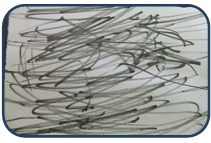
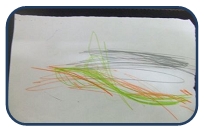
In between, she used green colour and scribbled lots of closely put up lines, again with a lot of pressure; the pressure with which she scribbled was so strong that the page got torn off. But, again, she picked up the black colour and drew a few small lines.
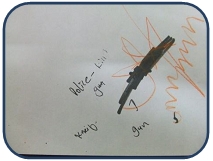
Again the child asked me for more pages, 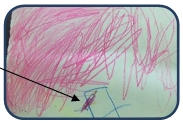
Then she picked up 
Then she stopped drawing and went close to her mom.
(When she was finished with scribbling, I decided to explore all her drawing, one after the other. I decided to actively intervene at this point because she had laid a significant PQRS through her drawings for me to inquire, and her mother had nothing further to add. Also, through her drawings, the way she held the pencil, the way she applied pressure while scribbling, her spontaneous words of knife, killing, etc., she herself connected the violence that I had observed as a central element of her energy pattern from the earlier history. So, now, I could see a faint pattern slowly emerge from the passive space that I had offered, and now it was time for me to intervene actively and understand all the PQRS, the mystery of puzzles that the child laid in front of me through her various drawings. So, I asked the child to describe her drawings one after another to solve the puzzle.)
P: (While describing first drawing) 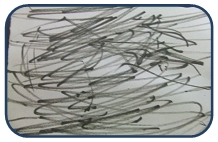
(Strange! I was amazed with this description of her drawing; from where did the crocodile come? But this was very peculiar and I had to inquire further and also of her other drawings, to see what she had to say there. Also, I also observed that she was deeply engrossed in her drawing while describing them. This kind of engrossment often speaks about the patient’s connection with their deeper self while they continue to describe things verbally. )
I asked her to tell more about that drawing but she just looked at me. So I went to the next drawing and asked her to describe it.
P: (while pointing at the black colour) Crocodile.
(When I showed the patient her drawings, these are the words that she kept repeating: crocodile, kill, police. And when she said crocodile, she pointed at black colour lines that she had scribbled over.)
Then the next drawing was the one where she murmured knife, police kill and where she had drawn a pointed object. I gave her that drawing and asked her to to describe it.)
P: Police kills the crocodile with knife (pointing at the sharp object she drew over the paper.
(Again she described the Crocodile. This time with more details and in this drawing, police were killing the crocodiles. The issues of violence, and killing that we got during the passive phase of the case, got connected and confirmed here.).
The drawing where she drew pink lines and a pointed object – she described as a knife.
(One after the other, I asked her to explain all her drawings and she said they are crocodile, crocodile is killing people and then police come with knife and kill the crocodiles. Here she used the same gesture of holding the knife that she used to hold the pencil. Also, in the initial phase of case she would just murmur unconnected two-three words, but to describe these drawings she could actually make half-broken sentences pointing at that we are on the right track. I am close to her central core. When patients move close to their center, their language gets clear and so are their expressions. ).
Finally, I asked her to describe her last drawing, where she scribbled black all over with a lot of pressure and anger in her face:
P: These are crocodiles. Many of them. They kill people. Police will come and kill them.
(Again, crocodile, kill, and the same story!!!)
When she had nothing more to reveal, I asked the mother what the child is sensitive to in watching television. The information that I got from the patient’s drawings were vital, and I thought to have a confirmation about the same by asking the mother what interests the child while watching television. Children will watch that which is their interest and they will take interest only in those topics that are close to their central core!
M: If there is any horrified scene shown, some violence, she wants me to change the channel. Like a wild animal killing other animal.
This proved that the child is sensitive to the issue of attack and defense, of predators killing the prey – vital information to confirm that her energy falls in animal kingdom.
I asked her if she liked watching animals on television to which the mother said “Yes”.
(Again, this confirmed that I was on right track to understand that this girl needed a remedy from the animal kingdom. However, it is very important to understand that not that children who love watching animals (on television/otherwise) will require a remedy from the animal kingdom. We need to see the entire picture to decide the source and the kingdom of source. In this case, the child’s energy expressed in all her drawings, her behaviors in my clinic as well as in her house, her expression of violence and her reactions expressing violence, plus her liking to watch animals on television and her sensitivity to wild animals (predator) attacking another animal (prey) in total suggests that this girl will need a remedy from the animal kingdom.)
But the mother said what she enjoyed most on television was to watch Hindi movies and advertisements. And then the mother said there was nothing more to add about her daughter.
So, I had to prescribe the remedy now. This is how I understood the case.
Understanding of the case:
This was not a case where the course of the case happened from the name of a disease to facts and then related emotions, delusions, sensation, and energy pattern. Neither was there a clear and out passive phase followed by Active and Active- Active phases of case witnessing. No?? This case did not travel in an ideal fashion. This case was different; the patient (child) was different; her expressions to reveal her deeper most disturbed vital energy pattern were different and so the demand to understand this case was also different and unique. And this is what usually happens with each individual case and more so in children cases. But yet, the magic of staying passive in my witnessing the child followed by active intervention, helped me to make sense out of all the non-sense, peculiar expressions that the child spontaneously laid in front of me. I had to maintain a relatively broader canvas while analyzing the PQRS facts that I could gather from this case, to form a totality that revealed the patient’s disturbed vital core.
This is how I followed the case and understood it:
Centre of the case: VIOLENCE and SYPHILITIC tendency–(the way she scribbled over the papers, the way she behaved with toys in clinic, the way she reacted with anger, her sensitivity towards the violence shown on television (a wild animal attacking another animal), her description of police killing the crocodiles, her physical complaints of violent pains in legs, severely infected molluscum, and her mother who suffered from severe DM/HT during pregnancy).
And this VIOLENCE had a pattern where somebody attacked the other, killed somebody (she killed mouse, police killed crocodile, crocodiles killed people, wild animal attacked another animal), all pointing at the animal kingdom
Also, her pattern of: Destruction, Stab/kill/knife/strike, Sudden violence (suddenly, she hit the toy very hard that she was holding in her hand over the ground and said “I killed the mouse“) Point towards the animal kingdom.
Another interesting pattern that we got about VIOLENCE is the element of SUDDENNESS.
And then, she described the CROCODILE in almost all her drawings.
It was interesting to note the energy with which she described the crocodile. All the energy patterns that we observed in various diverse areas of her life-be her anger pattern as mother described, be the way she stabs the toy in my chamber or be her talk of the killed mouse, or the way she scribbled harshly over the papers, all tune up exactly.
With the description of the crocodile, she not only connected all her above mentioned non-verbal expressions with her verbalization, but she connected all the fragmented non-verbal expressions that we got all throughout her case into one single pattern. We saw meaning in all the things she did spontaneously and all [rather only] words that she uttered all throughout the case (kill, stab with knife, sudden violence, killing mouse, killing crocodile.).
Thus, crocodile was not just the image but the source itself, as it connected all the peculiar energy expressions (including verbal and non-verbal) of the child in the case and came up repetitively in all her drawings.
Crocodiles belong to the reptilian class of the animal kingdom, which also includes snakes and lizards. Crocodiles are specifically known for violence, aggression, and destruction, especially sudden violent and aggressive behavior.
Understanding Crocodiles from the natural habitat:
(*2) A crocodile is any species belonging to the family Crocodylidae (sometimes classified instead as the subfamily Crocodylinae). The term can also be used more loosely to include all extant members of the order Crocodilia: i.e. the true crocodiles, the alligators and caimans (family Alligatoridae) and the gharials (family Gavialidae), as well as the Crocodylomorpha, which include prehistoric crocodile relatives and ancestors.
The basic difference amongst all four orders, sp. alligators and crocodile is the way their body plan is made up. It is found that Alligators strongly prefer freshwater, while crocodiles can better tolerate seawater due to specialized glands for filtering out salt. However, both can survive in either.
So, far as their behavioural pattern is considered, Crocodiles are more aggressive and reactive. When cleaning alligator pools, some zookeepers can tread on alligators without eliciting a response, though crocodiles almost invariably react aggressively and are for the most part more aggressive in their natural habitat.
Proving symptoms:
Alligator mississippiensis Proving (*3):
Anger: The anger could be intense and sudden. Mostly it manifested as irritability, coupled with intolerance and impatience. Several described it as a “chip on their shoulder”. The anger was easily triggered, especially by noise. Much of the issues here relate to feeling attacked and having to defend oneself, especially from others’ “stupidity”. Several described it as being “touchy” and “snappish”. One prover described it as follows:
“I was really irritable, intrusive thoughts throughout the day of anger and irritability. My terror was that I could not control my anger. If I did not, everything would explode. It was a feeling of infinite anger-so angry that I could destroy everything around me.” F
Fright and fear:
(Another prover) “I was asleep for one hour and woke up paralyzed with fear and total terror. I was frozen and could not move. It was the most fearful that I have ever been in my life.
Violence and rage
Crocodilians are mostly nocturnal hunters and rely on stealth, speed and surprise. They are idle hunters, lying in wait in the offshore shallows and relying on camouflage.
Other characteristic symptoms from the case:
Black colour
Fear to stay alone
Screams with fear
Crocodile
Infected molluscums
Violent anger
Remedy chosen: Crocodile 200 /one dose (I would have preferred 1M as the child resonated at a higher level of experience, but I had crocodile in 200 potency available with me then.)
Summary of follow ups:
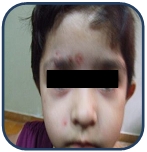
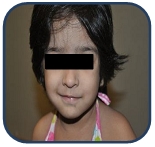
After that, her mother who also was my patient stopped coming with her daughter. On inquiring over the phone, she said because of her daughter’s school, she is not getting time to come for the follow ups. I knew the child (and the mother) both had a deep seated disturbed state with deep miasmatic influence and would require a long term follow up on homeopathy, to bring a balance in their lives; also, the level of awareness and lifestyle of the mother that was taking a toll on the child’s behavioral development and holistic improvement, needed a long term intervention and probably counseling sessions with the mother. I told the mother over the phone that if she continues with the homeopathic treatment without interruption then there was a lot of scope for her daughter (as well as her) to improve completely.
The mother continued to come infrequently to my clinic to collect medicine for her daughter whenever there were acute episodes of cold and cough. This year, she came twice so far, once in March 12 and then in July 12, both times when the child suffered from acute episode of cold. In both the instances, crocodile 200 was repeated. Now, in a span of one and a half years, the mollusum have not reappeared, the frequency and duration of cold episodes and leg pains have reduced considerably. The child who spoke two words now talks fluently. She still keeps getting leg pains infrequently for which her poor eating habits and her mother’s living habit (allowing her to have outside food on most days) also contributes. Her fears and anger still needs improvement. I feel the child will require homeopathic intervention for a long period, specifically because her mother finds it difficult to continue treatment on a regular basis. The mother herself also needs to adapt to a better and healthy way of living to which she still pays no heed.
Case ends.
*Bibliography:
*1: Chauhan Dr. Dinesh; A Wander with A Little Wonder: Child Centric case Witnessing;Philosia Publications, India
*2: wikipedia.org/wiki/Crocodile
*3:http://www.amcofh.org (American Medical College of Homeopathy)



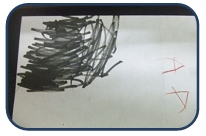
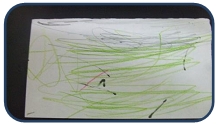
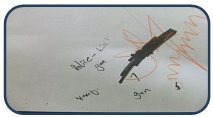

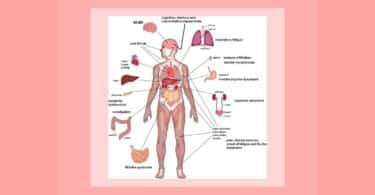
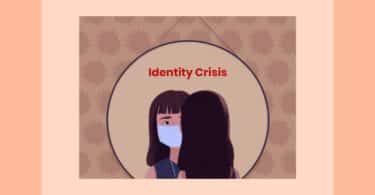

thank you for sharing this case,wonderfully presented
Dear Gina,
Thank you for your kind appreciation.
dear mam,
Thanks for presenting this case step by step, but how & do we know about selecting an animal or vegetable kingdom remedy on the basis of the symptoms?
dear Dr. Vivek,
we always select a remedy (be that from any kingdom) depending upon the Totality of symptoms at holistic level of a patient. When i say Holistic level- that means Body+Mind+ beyond the MIND/BODY Complex (one that unites them- i.e. the vital sensation and the vital core) and we always take up the most striking, strange looking, peculiar symptoms (PQRS)at all the above mentioned holistic levels –
The best part is, when we gather such symptoms from the patients , while taking their history, we usually get PQRS at Mind and Body levels and they look so different, unconnected to each other, often putting us in dilemna while doing a selection of simillimun post evaluation and repertorisation. But, when we travel a step ahead in the case, and try to explore the deeper level then Mind and Body, all the PQRS starts getting connected, making a single pattern connected in a single thread, pointing precisely at the simillimum and then search for simillimum from available PQRS at holistic level helps us to decide Kingdom, sub-kingdom and often even the source with ease and success.
This is what you will see in even my above case of a child- trying to explore her PQRS at the holistic level-
And, also, here is where we get the importance of understanding our fundamentals about how to explore the symptoms right till the deepest core/vital core in a case to understand Holistic symptoms of the case with a relative ease and success and reproduce that in each and every case with clarity – and thats where the case witnessing process has been a great help to me so far.
do feel free to come back with any further queries.
you can also post your queries related to case taking/case witnessing in the “Forum” of my web site http://www.casewitnessing.com – again, you will find answers to many of such questions and posts plus many articles over case witnessing process.
with warm regards,
Dr. Urvi Chauhan